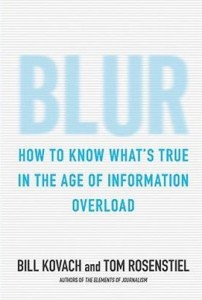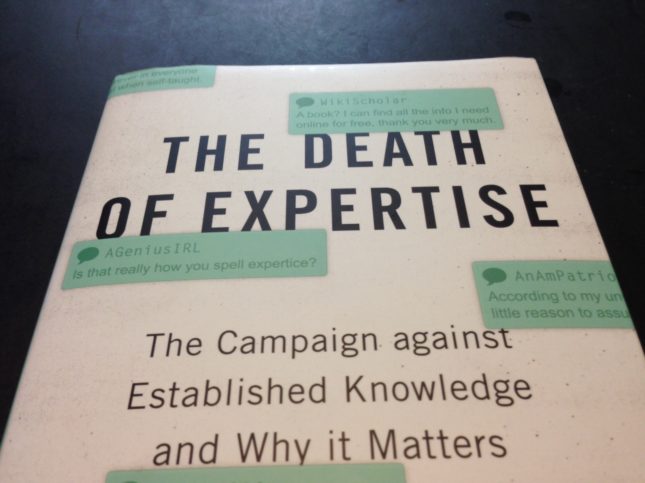Blur: How to Know What’s True in the Age of Information Overload, by Bill Kovach and Tom Rosenstiel
 One of the central themes of Practical Eloquence is that content is king. If you take your responsibilities as a persuader or a decision maker seriously, then Blur is an important book for you because sound decisions depend on sound knowledge. Paradoxically, there is so much information available today, from so many sources, that knowledge is harder to come by. As Blur tells us: ”When information is in greater supply, knowledge becomes harder to create, because we have to sift through more data to arrive at it. Confusion and uncertainty are more likely.”
One of the central themes of Practical Eloquence is that content is king. If you take your responsibilities as a persuader or a decision maker seriously, then Blur is an important book for you because sound decisions depend on sound knowledge. Paradoxically, there is so much information available today, from so many sources, that knowledge is harder to come by. As Blur tells us: ”When information is in greater supply, knowledge becomes harder to create, because we have to sift through more data to arrive at it. Confusion and uncertainty are more likely.”
Besides the sheer volume, another complication is the tension between fact and faith. So much of the information we rely on for informed decisions has to be taken on faith. In a simpler age, most of what had an immediate impact on our lives happened close by, so we could rely on observable fact in making decisions. When companies were smaller, we knew the people involved or we knew our customers personally, so we either had a chance to see things firsthand or had a reliable sense of the trustworthiness of our source. As the world has become larger, more complicated and more connected, more of what affects us happens further away, so we have to make more decisions based on what someone else tells us—in other words to take their information on faith.
Faith is a wonderful mechanism for saving time, but it can lead you astray unless you can trust the sources in which you have faith. For better or worse, we tended to have more faith in our sources, either the government or the venerable and respected newsmen on the nightly news, and the fat Sunday paper. They were in effect the gatekeepers of our news; we heard only what they said, relied on it, and it was all good.
Then came Vietnam, Watergate, cable TV and finally the Internet, and the floodgates opened. Trust in our major sources of information fell, the number of sources exploded exponentially, and new forms of content blurred the lines between journalism, entertainment, advertising and ideology.
Today we are all empowered to seek out our own sources, but with that power comes responsibility. We have to be our own gatekeepers, and Blur provides ideas to help us with that critical task.
The first step is to classify the nature of the content you are consuming, according to this classification:
- Journalism of verification: the traditional newspaper model that places a high premium on accuracy and context. These journalists live by the motto: “If your mother says she loves you, check it out.” They also try to dig deeper than the immediate events to provide context that makes the meaning more complete.
- Journalism of assertion: premium is placed on speed and volume of information. Think of this as a bank of cameras which are always on. You see a lot, but it’s passive, without the verification and sense-making that journalism of verification provides. In effect, you get all the raw data, including rumors, assertions, innuendoes, conflicting reports, and accusations, and you get to try to figure out what’s really happening.
- Journalism of affirmation: the sources that people follow primarily to affirm and reinforce their beliefs, which tend to choose only those stories that support their particular ideology or point of view.
- Interest-group journalism: these are not usually news at all. They’re funded by special interests to and designed to look like news.
Although the authors don’t say it, it seems to me that if you limit your news sources to the first two types, you’ll be automatically better off.
Step two is to ask yourself what is missing from the information. A story can be precisely accurate and yet not be sufficient. In addition to the old standard six questions of who, what, when, where, why and how, they urge us to add a Q: what questions are raised by this story? This is the step that allows you to understand the events in context. And, although it is not in the book, I would also add one more question, which is possibly a subset of Q: so what? What does this mean to me and what should I do with the information?
Steps three and four deal with the two principal questions related to data, who are the sources what is the nature of the evidence that is adduced? Graduates of my Precision Questioning class will recognize these two steps as the Basic Critical Question category.
The fifth step is to consider whether there is an alternative explanation, which is very useful in making sense of events and avoiding rash reactions.
Finally, the sixth step is extremely useful to anyone interested in personal development and learning. Because there is so much information available, no one has time to see it all, and we must be extremely selective, but not so selective that we wrap ourselves into a comfortable cocoon of confirmation. As the authors say, “…we should ask ourselves if we are really asking questions. Are we really trying to expand our knowledge? Are we willing to entertain the possibility that we might have something to learn, that we might even change our minds, or at least our understanding?”
If you care about these questions, not only in your daily news consumption but also with regard to the tons of information you come across in your work life, then I urge you to read this book.



